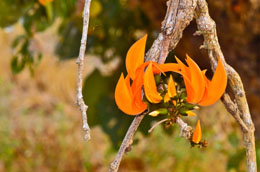Parrot flower is known for its beauty and is found in Southeast Asia. Initially it was said that images of this flower were digitally created, but now it has been accepted that it truly exists. Scroll down to know about this wonderful creation of nature.

Parrot flower is one of those rare flowers which cannot be grown in the household garden. Although, it is said that the flower is found in various countries in Southeast Asia, it has been predominantly found only in the tropical forests of Thailand. Thailand has declared it to be a protected species and there is a ban on export of this plant.
Parrot Flower Information
The scientific name of parrot flower is
Impatiens psittacina. It is also known as 'parrot balsam', because it is a species of balsam. It was initially described by the botanist Joseph Dalton Hooker. The flower became popular for its resemblance to a 'flying cockatoo'. Even in Thailand it was more commonly found in Shan States, by a British official. The seeds of this flower were presented to the Royal Gardens in 1899 and the plant flowered in 1900.
This flower needs an extremely hot and wet climate, as is found in Thailand, Myanmar and also in some parts of India. Many assume that it is the climate, due to which the flower cannot be grown by gardeners around the world. However, there are a few more reasons as well. One of the primary reason is that the flower is protected and cannot be exported. Although you may come across some websites on the Internet which claim to sell the seeds of the flowers, the seeds may be of flowers that are similar to parrot flowers, but not of parrot flowers themselves. The other reason why the plant has successfully not grown in other parts of the world is because its pollinator is not known. There are different beliefs about the pollinators, some say it is a small bat or a small bird, which has a tongue long enough to reach inside the flower. Others believe that the pollinator may be a wasp or large bees.
Although the flower looks beautiful, the plant is not a beautiful sight. It grows into a bush, which is untidy, and wide-leafed, and may grow as tall as six feet high. One may have to bear with the unsightly sight for about 10 months in the year, as it blooms only for a few weeks around October-November every year.
The flowers are harvested when they are fully mature. They do not open past the stage, at which the flowers are harvested. So that the flowers last for an extended period of time, the bracts are opened at a lesser area. Normally the flowers do not open any further after harvest and they may lose their visual appeal.
The flower has thick stems, and the leaves have a serrulate margin. The color of the flower is often light purple to carmine red. The lateral sepals are orbicular and light green in color, whereas the lower sepal is bulbous and gradually narrows into a hooked spur tipped in carmine. While the dorsal petal is orbicular and hooded, it is the lateral united petals, that are long.
Till recent times, the parrot flower was said to be native to Southeast Asia and Thailand, though, it has recently been claimed to be found also in the tropical climates of America. The claim, however, is yet to be verified. Some florists also claim to stock these flower. This is another claim which needs ratification.






 Parrot flower is one of those rare flowers which cannot be grown in the household garden. Although, it is said that the flower is found in various countries in Southeast Asia, it has been predominantly found only in the tropical forests of Thailand. Thailand has declared it to be a protected species and there is a ban on export of this plant.
Parrot flower is one of those rare flowers which cannot be grown in the household garden. Although, it is said that the flower is found in various countries in Southeast Asia, it has been predominantly found only in the tropical forests of Thailand. Thailand has declared it to be a protected species and there is a ban on export of this plant.